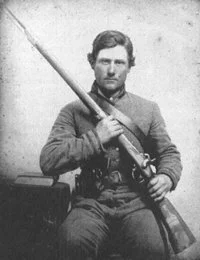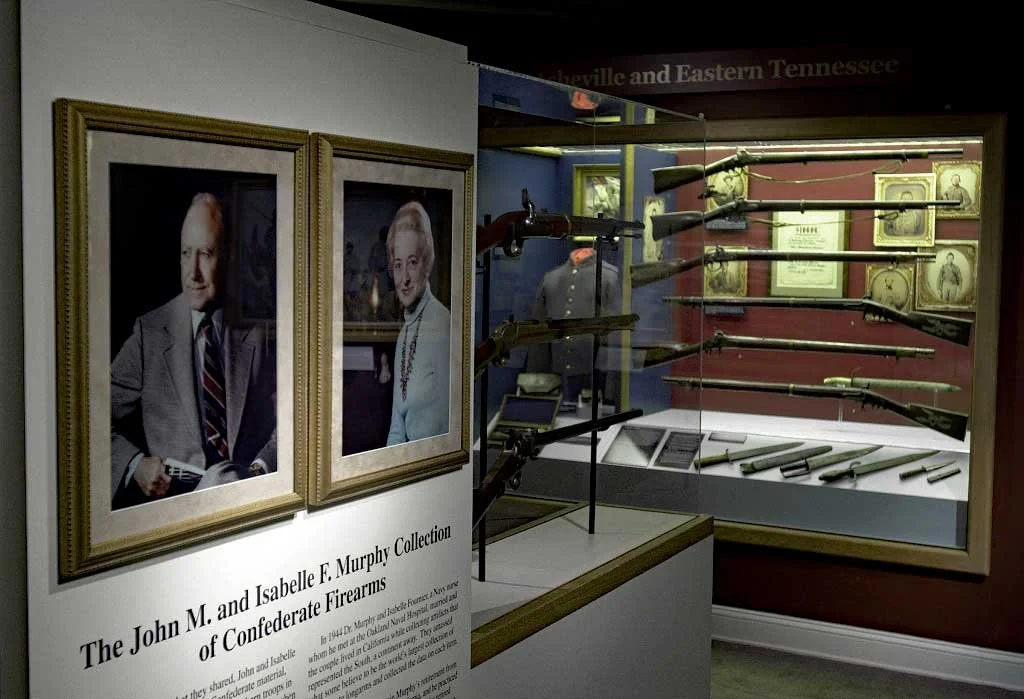Museum Pieces
Tarpley Carbine
The end of the Civil War saw the country awash in weapons of all kinds. Over a million short and long arms had been imported and armories in the North and South were running at full capacity right up to Lee's surrender. Yet the cessation of hostilities did not see these swords turned into plowshares. Many of the better-quality arms were exported and sold to help pay down government war debts while others went west to arm Cowboys and Indians alike.
It's All Over but the Shooting
Demobilized Union soldiers were in the habit of bringing captured rifles home with them. Many of these war trophies featured custom engraving and polished brass fittings, all the better to display above the mantle for future generations to admire.
The situation was somewhat different for the defeated warriors of the South. Although regional Union commanders were given some discretion, many Confederate veterans were allowed to keep their rifles as it was assumed they would be needed to provide sustenance for their families.
In doing so, the Union was taking some risk: there were voices in the South who advocated continuing resistance and guerilla warfare, and other voices in the North who predicted that would come to pass.
Nevertheless, thousands of Confederate rifles saw use in the post-war years as hunting weapons. These guns were used hard, often until they were worn out. Others rested (and rusted) in attics and basements, slowly succumbing to the effects of Southern humidity in the long decades before the advent of air conditioning.
Nevertheless, thousands of Confederate rifles saw use in the post-war years as hunting weapons. These guns were used hard, often until they were worn out. Others rested (and rusted) in attics and basements, slowly succumbing to the effects of Southern humidity in the long decades before the advent of air conditioning.
Dr. Murphy's Mission
Dr. John M. Murphy grew up in Virginia's Shenandoah Valley listening to stories of the Civil War told by his elder relatives. The tales of courage and desperation related by these and other local veterans instilled in the young Murphy a desire to seek out the finest examples of the many different rifles used by Confederate soldiers.
In that respect he was eminently successful. Dr. Murphy and his wife Isabel spent the years after his retirement following leads and purchasing Confederate rifles, carbines and muskets from across the country, eventually accumulating over 140.
Some of the makers include Morse, Cook & Brother, Cody & Son, Read & Watson, Sharps and Hall. Several of the rifles were made by small regional craftsmen and had very low production runs.
One of these was the Tarpley carbine. Designed by Jeremiah Tarpley and manufactured in Greensboro and Guilford County, NC. by J. F. Garrett & Company, the Tarpley was a breech-loading carbine firing .52 caliber ammunition. Its short barrel and breech-loading capability made it a favorite of Confederate cavalrymen who had to fire and reload on the fly. Tarpley carbines deteriorated rapidly with use, however, due to the lack of a gas seal between the breech block and the gun barrel.
Several hundred were made; less than 20 have survived to this day. A half-dozen Tarpley carbines are included in the Greensboro museum's collection along with other rarities like the Texas Rifle and the guns produced by the Palmetto Armory.
Mustering the Musketry
The Greensboro Historical Museum is the proud home of the "John M. and Isabel Murphy Collection of Confederate Firearms" which comprises nearly all of the museum's 150+ CSA rifles and accessories. Dr. Murphy contemplated many offers to host his unique collection including the Smithsonian Institution in Washington before settling on the Greensboro museum.
The Murphy Collection began with the purchase of a locally-made Tarpley carbine and perhaps that had something to do with his choice of Greensboro. In any event, the museum staff will be kept busy investigating, cataloguing, and otherwise curating this splendid collection of Civil War weaponry for many years to come.
The Greensboro Historical Museum is located at 130 Summit Avenue in downtown Greensboro. Besides the Murphy Collection, the museum features the Hall of Military History, a renowned collection of Jugtown Pottery from nearby Seagrove dating back to the 1920s, and many more exhibits of local and national interest.
The museum is open Tuesday through Saturday, call (336) 373–2043 for details or visit them online at greensborohistory.org
by Steve Levenstein, 2006 ©RLinc




